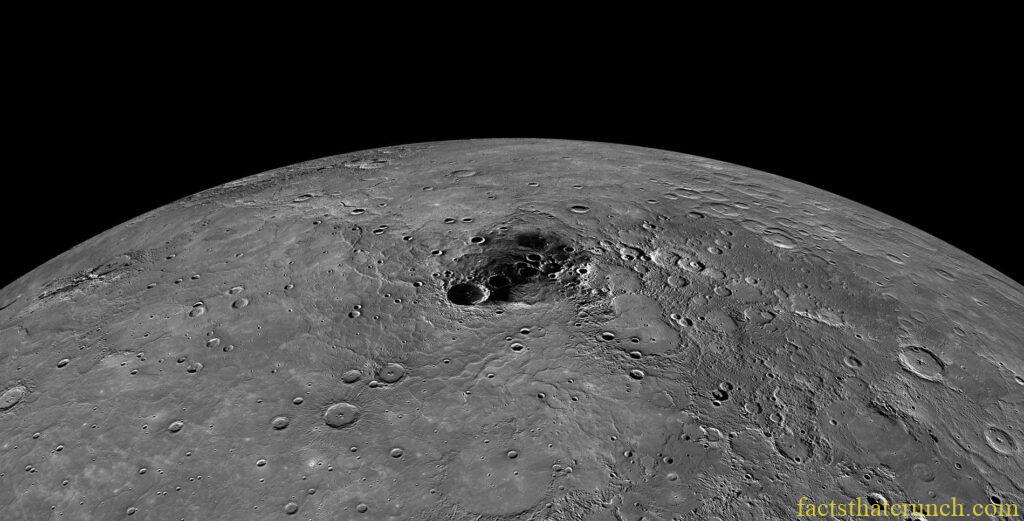5 Incredible Planet Mercury Facts
Let’s explore 5 amazing planet Mercury facts! Mercury, the closest planet to the Sun, often goes unnoticed in the popular imagination, overshadowed by its more flamboyant planetary neighbors. Yet, this small, rocky body harbors a range of fascinating and somewhat eerie characteristics that defy its unassuming reputation.
Our solar system is made up of 8 planets, including: Mercury, Venus, Earth, Mars, Jupiter, Saturn, Uranus, and Neptune. There are five officially recognized dwarf planets in our solar system: Ceres, Pluto, Haumea, Makemake, and Eris.
1. Mercury’s Extreme Temperature Swings
Imagine a place where the temperature can skyrocket to 800 degrees Fahrenheit (430 degrees Celsius) in the sunlight and then plunge to a frigid -290 degrees Fahrenheit (-180 degrees Celsius) in the shadow. Mercury experiences the most extreme temperature variations of any planet in our solar system, due to its thin atmosphere which is incapable of trapping heat. During the Mercurian day, the surface gets hot enough to melt lead, and at night, it becomes one of the coldest places in the solar system. This extreme contrast is not only fascinating but also creates a stark landscape of thermal extremes, painting a picture of a planet that is both a fiery inferno and a frozen wasteland.
2. The Enigmatic Ice in Mercury’s Shadow
On a planet so close to the Sun, where daytime temperatures can melt metal, it seems inconceivable that there could be ice. Yet, deep within the permanently shadowed craters of Mercury’s poles, water ice has been found. These craters are eternally shielded from the Sun’s scorching rays, preserving the ice against all odds. The presence of ice on such a blisteringly hot planet is not only a striking contrast but also an eerie reminder of the stark differences that can exist in such a small spatial area. This ice might provide clues about the planet’s history and perhaps the solar system’s past as well.

3. Mercury’s Wandering Orbit and Chaotic Spin
Mercury’s orbit around the Sun is the most eccentric (oval-shaped) of any planet in our solar system. Additionally, the planet exhibits a bizarre rotational pattern known as a 3:2 spin-orbit resonance. This means that for every two orbits it completes around the Sun, it rotates three times on its axis. This odd behavior results in a day on Mercury (one sunrise to the next) lasting about 176 Earth days. What’s more, Mercury’s orbit is gradually shrinking, causing it to inch closer to the Sun every century. This slow-motion spiral, combined with its strange rotational dance, adds a layer of dynamism and unpredictability to this little planet.
4. The Incredible Shrinking Planet Mercury
Mercury is contracting. Over billions of years, its iron core has cooled and solidified, causing the planet to shrink and its surface to crumple. This has resulted in a landscape marked by towering cliffs and ridges, some soaring up to a mile high, stretching for hundreds of miles across the planet’s face. These massive geological formations, known as “lobate scarps,” are essentially the wrinkles of a planet slowly compressing under its own aging process. The thought of a planet shrinking over time, its surface buckling like the skin of a withering apple, adds an eerie aspect to Mercury’s geological activity.

5. Mercury’s Tail: The Comet-Like Planet
Unlike any other planet, Mercury possesses a comet-like tail. This tail is formed by the solar wind blasting particles off Mercury’s surface and into space, creating a stream of atoms that trails behind the planet. Mercury’s exosphere, which is the ultra-thin atmosphere it hosts, is constantly replenished by these solar wind interactions and micrometeoroid impacts. Observing this tail, which can extend up to 1.5 million miles (2.4 million kilometers) into space, is like watching a planet masquerade as a comet. The haunting visual of a rocky planet shedding material into space enhances the mysterious and volatile nature of Mercury.
Planet Mercury Facts: Summary
Mercury, with its extreme environments, hidden ice, peculiar orbital dance, shrinking surface, and comet-like tail, stands as a testament to the solar system’s capacity for wonder and weirdness. These little-known facts not only underscore the dynamic and often extreme nature of planetary science but also highlight how much remains to be discovered about our closest planetary neighbor to the Sun. Mercury, a tiny dot in our telescopes, is a reminder of the intriguing complexities and eerie phenomena that await exploration in even the smallest corners of our solar system. So, the next time you look up at the sky, remember that even the least assuming planets can host some of the most astonishing secrets.

